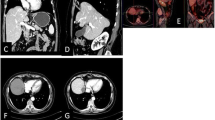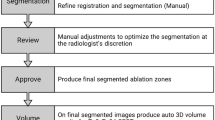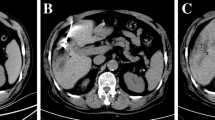Abstract
To retrospectively assess the predictive value of the CT performed at 24 h, compared with the CT performed at 1 month, in the evaluation of the technical success of microwave (MW) ablation of hepatic lesions. In a single center, 50 patients with HCC underwent percutaneous MW ablation between November 2016 and March 2019. Each patient underwent a contrast-enhanced CT exam at 24 h and at 1 month after the procedure. For each patient, was assessed the presence or absence of residual disease, the appearance of a new lesion, complications, and the involvement of the hepatic capsule, both at 24-h and at 1 month. Overall correlation between residual disease, appearance of a new nodule and complications was also assessed. A total of 50 hepatic lesions were treated with US-guided MW ablation. Patients’ mean age was 70.9 years (range 28–87 years). Mean nodule diameter was 17.6 mm (range 7–35 mm). Contingency tables and the χ2 test showed a strong association when looking at capsule involvement (accuracy: 100%), residual disease (accuracy: 90%; p-value 0.003), and the appearance of a new HCC nodule (accuracy: 88%; p-value 0.007); regarding complications, the accuracy was 78% (p-value 0.014). Optimal correlation was reached in 62% of cases, moderate correlation in 26%, minimum correlation in 10% of cases; no cases of zero correlation were recorded. CT at 24 h and 1 month showed comparable efficacy in evaluating residual disease after MW thermal ablation of liver lesions. However, further studies are needed to assess which factors may cause false-negative results at the 24-h CT.



Similar content being viewed by others
References
Galle PR, Forner A, Llovet JM, Mazzaferro V, Piscaglia F, Raoul JL, Schirmacher P, Vilgrain V. EASL Clinical Practice Guidelines: Management of hepatocellular carcinoma. J Hepatol. 2018;69:182–236. https://doi.org/10.1016/j.jhep.2018.03.019.
Galun D, Basaric D, Zuvela M, Bulajic P, Bogdanovic A, Bidzic N, Milicevic M. Hepatocellular carcinoma: from clinical practice to evidence-based treatment protocols. World J Hepatol. 2015;7:2274. https://doi.org/10.4254/wjh.v7.i20.2274.
Shady W, Petre EN, Do KG, Gonen M, Yarmohammadi H, Brown KT, Kemeny NE, D’Angelica M, Kingham PT, Solomon SB, Sofocleous CT. Percutaneous microwave versus radiofrequency ablation of colorectal liver metastases: ablation with clear margins (A0) provides the best local tumor control. J Vasc Interv Radiol. 2018;29:268–275.e1. https://doi.org/10.1016/j.jvir.2017.08.021.
Arora A, Kumar A. Treatment response evaluation and follow-up in hepatocellular carcinoma. J Clin Exp Hepatol. 2014;4:S126–S129129. https://doi.org/10.1016/j.jceh.2014.05.005.
Bruix J, Sherman M, Llovet JM, Beaugrand M, Lencioni R, Burroughs AK, Christensen E, Pagliaro L, Colombo M, Rodés J. Clinical Management of hepatocellular carcinoma. Conclusions of the Barcelona-2000 EASL conference. J Hepatol. 2001;35:421–30. https://doi.org/10.1016/S0168-8278(01)00130-1.
Lencioni R. New data supporting modified RECIST (mRECIST) for hepatocellular carcinoma. Clin Cancer Res. 2013;19:1312–4. https://doi.org/10.1158/1078-0432.CCR-12-3796.
Smith TJ. Breast cancer surveillance guidelines. J Oncol Pract. 2013;9:65–7. https://doi.org/10.1200/JOP.2012.000787.
Lieng H, Warde P, Bedard P, Hamilton RJ, Hansen AR, Jewett MAS, O’malley M, Sweet J, Chung P. Recommendations for followup of stage I and II seminoma: the Princess Margaret Cancer Centre approach. Can Urol Assoc J. 2018;12:59–66. https://doi.org/10.5489/cuaj.4531.
Vogel A, Cervantes A, Chau I, Daniele B, Llovet JM, Meyer T, Nault JC, Neumann U, Ricke J, Sangro B, Schirmacher P, Verslype C, Zech CJ, Arnold D, Martinelli E. Hepatocellular carcinoma: ESMO Clinical Practice Guidelines for diagnosis, treatment and follow-up. Ann Oncol. 2019;30:871–3. https://doi.org/10.1093/annonc/mdy510.
Crocetti L, De Baere T, Lencioni R. Quality improvement guidelines for radiofrequency ablation of liver tumours. Cardiovasc Intervent Radiol. 2010;33:11–7. https://doi.org/10.1007/s00270-009-9736-y.
Bolondi L, Cillo U, Colombo M, Craxì A, Farinati F, Giannini EG, Golfieri R, Levrero M, Daniele Pinna A, Piscaglia F, Raimondo G, Trevisani F, Bruno R, Caraceni P, Ciancio A, Coco B, Fraquelli M, Rendina M, Squadrito G, Toniutto P. Position paper of the Italian Association for the Study of the Liver (AISF): the multidisciplinary clinical approach to hepatocellular carcinoma. Dig Liver Dis. 2013;45:712–23. https://doi.org/10.1016/j.dld.2013.01.012.
D. NCI, NIH (2009) Common terminology criteria for adverse events v4.0. NIH Publ. pp 0–71
Filippiadis DK, Binkert C, Pellerin O, Hoffmann RT, Krajina A, Pereira PL. Cirse quality assurance document and standards for classification of complications: the cirse classification system. Cardiovasc Intervent Radiol. 2017;40:1141–6. https://doi.org/10.1007/s00270-017-1703-4.
Boas FE, Do B, Louie JD, Kothary N, Hwang GL, Kuo WT, Hovsepian DM, Kantrowitz M, Sze DY. Optimal imaging surveillance schedules after liver-directed therapy for hepatocellular carcinoma. J Vasc Interv Radiol. 2015;26:69–73. https://doi.org/10.1016/j.jvir.2014.09.013.
Santi V, Trevisani F, Gramenzi A, Grignaschi A, Mirici-Cappa F, Del Poggio P, Di Nolfo MA, Benvegnù L, Farinati F, Zoli M, Giannini EG, Borzio F, Caturelli E, Chiaramonte M, Bernardi M. Semiannual surveillance is superior to annual surveillance for the detection of early hepatocellular carcinoma and patient survival. J Hepatol. 2010;53:291–7. https://doi.org/10.1016/J.JHEP.2010.03.010.
Lim HK, Choi D, Lee WJ, Kim SH, Lee SJ, Jang H-J, Lee J-H, Lim JH, Choo IW. Hepatocellular carcinoma treated with percutaneous radio-frequency ablation: evaluation with follow-up multiphase helical CT. Radiology. 2001;221:447–54. https://doi.org/10.1148/radiol.2212010446.
Lewandowski RJ, Kulik LM, Riaz A, Senthilnathan S, Mulcahy MF, Ryu RK, Ibrahim SM, Sato KT, Baker T, Miller FH, Omary R, Abecassis M, Salem R. A comparative analysis of transarterial downstaging for hepatocellular carcinoma: chemoembolization versus radioembolization. Am J Transpl. 2009;9:1920–8. https://doi.org/10.1111/j.1600-6143.2009.02695.x.
Liu W, Zheng Y, Zou R, Shen J, He W, Yang Z, Zhang Y, Li B, Yuan Y. Impact of follow-up interval on patients with hepatocellular carcinoma after curative ablation. BMC Cancer. 2018;18:1–9. https://doi.org/10.1186/s12885-018-5069-z.
Yaghmai V, Besa C, Kim E, Gatlin JL, Siddiqui NA, Taouli B. Imaging assessment of hepatocellular carcinoma response to locoregional and systemic therapy. Am J Roentgenol. 2013;201:80–96. https://doi.org/10.2214/AJR.13.10706.
Goldberg SN, Grassi CJ, Cardella JF, Charboneau JW, Dodd GD, Dupuy DE, Gervais DA, Gillams AR, Kane RA, Lee FT, Livraghi T, McGahan J, Phillips DA, Rhim H, Silverman SG, Solbiati L, Vogl TJ, Wood BJ, Vedantham S, Sacks D. Image-guided tumor ablation: standardization of terminology and reporting criteria. J Vasc Interv Radiol. 2009;20:S377–S390390. https://doi.org/10.1016/j.jvir.2009.04.011.
Heimbach JK, Kulik LM, Finn RS, Sirlin CB, Abecassis MM, Roberts LR, Zhu AX, Murad MH, Marrero JA. AASLD guidelines for the treatment of hepatocellular carcinoma. Hepatology. 2018;67:358–80. https://doi.org/10.1002/hep.29086.
Benson AB, D’Angelica MI, Abbott DE, Abrams TA, Alberts SR, Anaya DA, Are C, Brown DB, Chang DT, Covey AM, Hawkins W, Iyer R, Jacob R, Karachristos A, Kelley RK, Kim R, Palta M, Park JO, Sahai V, Schefter T, Schmidt C, Sicklick JK, Singh G, Sohal D, Stein S, Tian GG, Vauthey J-N, Venook AP, Zhu AX, Hoffmann KG, Darlow S. NCCN guidelines insights: hepatobiliary cancers, version 1.2017. J Natl Compr Cancer Netw. 2017;15:563–73. https://doi.org/10.6004/jnccn.2017.0059.
Puijk RS, Ruarus AH, Scheffer HJ, Vroomen LGPH, van Tilborg AAJM, de Vries JJJ, Berger FH, van den Tol PMP, Meijerink MR. Percutaneous liver tumour ablation: image guidance, endpoint assessment, and quality control. Can Assoc Radiol J. 2018;69:51–62. https://doi.org/10.1016/j.carj.2017.11.001.
Liang P, Yu J, De Lu M, Dong BW, Yu XL, Zhou XD, Hu B, Xie MX, Cheng W, He W, Jia JW, Lu GR. Practice guidelines for ultrasound-guided percutaneous microwave ablation for hepatic malignancy. World J Gastroenterol. 2013;19:5430–8. https://doi.org/10.3748/wjg.v19.i33.5430.
Patel N, King AJ, Breen DJ. Imaging appearances at follow-up after image-guided solid-organ abdominal tumour ablation. Clin Radiol. 2017;72:680–90. https://doi.org/10.1016/j.crad.2017.01.014.
Venkatesan AM, Gervais DA, Mueller PR. Percutaneous radiofrequency thermal ablation of primary and metastatic hepatic tumors: current concepts and review of the literature. Semin Intervent Radiol. 2006;23:73–84. https://doi.org/10.1055/s-2006-939843.
Rhim H, Goldberg SN, Dodd GD, Solbiati L, Lim HK, Tonolini M, Cho OK. Essential techniques for successful radio-frequency thermal ablation of malignant hepatic tumors. RadioGraphics. 2001;21:S17–S35. https://doi.org/10.1148/radiographics.21.suppl_1.g01oc11s17.
Ebara M, Hatano R, Fukuda H, Yoshikawa M, Sugiura N, Saisho H. Natural course of small hepatocellular carcinoma with underlying cirrhosis. A study of 30 patients. Hepatogastroenterology. 1998;45(Suppl 3):1214–20.
Barbara L, Benzi G, Gaiani S, Fusconi F, Zironi G, Siringo S, Rigamonti A, Barbara C, Grigioni W, Mazziotti A, Bolondi L. Natural history of small untreated hepatocellular carcinoma in cirrhosis: A multivariate analysis of prognostic factors of tumor growth rate and patient survival. Hepatology. 1992;16:132–7. https://doi.org/10.1002/hep.1840160122.
Author information
Authors and Affiliations
Corresponding author
Ethics declarations
Conflict of interest
The authors declare that they have no conflict of interest.
Additional information
Publisher's Note
Springer Nature remains neutral with regard to jurisdictional claims in published maps and institutional affiliations.
Rights and permissions
About this article
Cite this article
Fumarola, E.M., Ierardi, A.M., Biondetti, P. et al. Follow-up of percutaneous microwave (MW) ablation of hepatic lesion: predictive value of CT at 24-h compared with CT at 1 month. Med Oncol 37, 41 (2020). https://doi.org/10.1007/s12032-020-01364-y
Received:
Accepted:
Published:
DOI: https://doi.org/10.1007/s12032-020-01364-y




